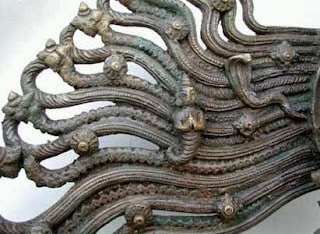The Nataraja dances within the universe of illusion. The locks of his hair stand out in many strands as he whirls around in his dancing frenzy. His locks are decked with a crescent moon, a skull, and are interspersed with the sacred river Ganges.
Shiva's unkempt hair, a symbol of a rejection of society, shows him to be an ascetic. This contrasts with his role as a grhastha, or householder, with his wife and family.
The fiery ring surrounding Shiva, prahabhamandala, represents the universe with all its illusion, suffering and pain. The outer edge is fire the inner edge the waters of the oceans. Many Nataraja statues have multiple levels of fire and water
The goddess of the Ganges is here shown nesting in Shiva's dreadlocks. The river Ganges that flows in Nataraja's hair originally flowed in heaven. When the heavenly Ganges was needed on earth, she was unwilling to fall to earth because she realized that her fall from heaven would be too much for the earth to withstand. Shiva as Nataraja agreed to break the violent power of the sacred Ganga's fall by catching her in his tangled hair, breaking the fall with his hair on its way to the Himalayas and Northern India
The crescent moon in his matted hair keeps Kama, the god of nightly love, alive. Through the waxing and the waning of the moon Shiva creates different seasons and rejuvenates life.
Nataraja wears a snake coiled around his upper arms and neck symbolizing the power he has over the most deadly of creatures. Snakes are also used to symbolize the Hindu dogma of reincarnation. Their natural process of molting or shedding their skin is symbolic of the human souls transmigration of bodies from one life to another.
In the back right hand Shiva often holds an hour glass shaped drum or damaru. The drum represents the rhythmic sound to which Nataraja dances and ceaselessly recreates the universe.
The front right hand is in the abhaya-mudra (the "fear not" gesture, made by holding the palm outward with fingers pointing up).
The back left hand carries agni (fire) in a vessel or in his hand. The flames represent the destructive energy with which Nataraja dances at the end of each cosmic age, cleansing sins and removing illusion

The front left hand is across the chest in the gahahasta (elephant trunk) pose, with the wrist limp and the fingers pointed downward toward the uplifted foot.
His uplifted left foot, grants eternal bliss to those who approach him. The other foot treads firmly upon the dwarf of ignorance, allowing the birth of knowledge.
Nataraja dances above the body of the demon, Apasmara, whom he has killed; in this role he is called Natesa. Apasmara, the dwarf demon, represents the ignorance of teaching that all opposites (for example good and evil) are false.


















